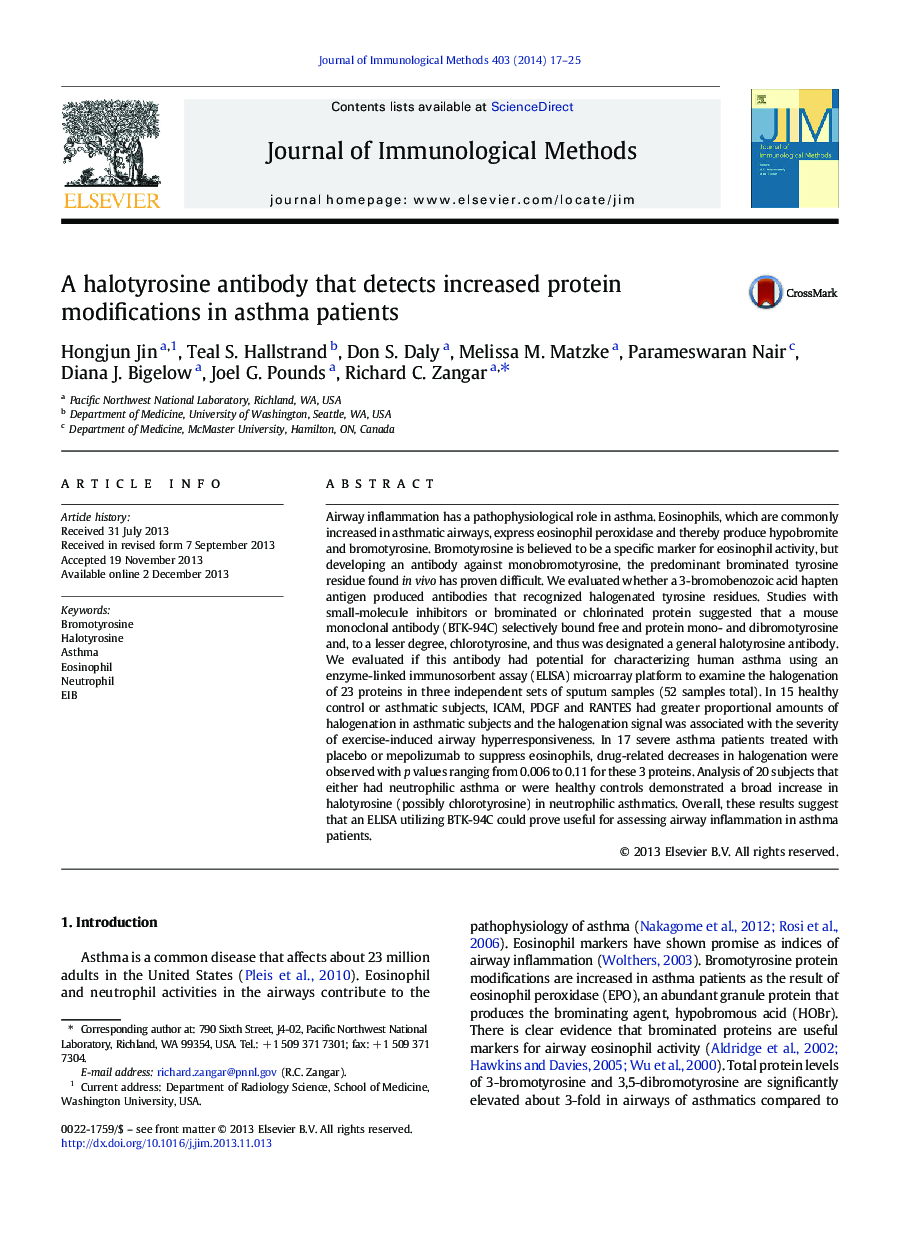| کد مقاله | کد نشریه | سال انتشار | مقاله انگلیسی | نسخه تمام متن |
|---|---|---|---|---|
| 8417831 | 1545706 | 2014 | 9 صفحه PDF | دانلود رایگان |
عنوان انگلیسی مقاله ISI
A halotyrosine antibody that detects increased protein modifications in asthma patients
ترجمه فارسی عنوان
یک آنتی بادی هالوتیرین است که تغییرات پروتئین افزایش یافته در بیماران مبتلا به آسم را تشخیص می دهد
دانلود مقاله + سفارش ترجمه
دانلود مقاله ISI انگلیسی
رایگان برای ایرانیان
موضوعات مرتبط
علوم زیستی و بیوفناوری
بیوشیمی، ژنتیک و زیست شناسی مولکولی
بیوتکنولوژی یا زیستفناوری
چکیده انگلیسی
Airway inflammation has a pathophysiological role in asthma. Eosinophils, which are commonly increased in asthmatic airways, express eosinophil peroxidase and thereby produce hypobromite and bromotyrosine. Bromotyrosine is believed to be a specific marker for eosinophil activity, but developing an antibody against monobromotyrosine, the predominant brominated tyrosine residue found in vivo has proven difficult. We evaluated whether a 3-bromobenozoic acid hapten antigen produced antibodies that recognized halogenated tyrosine residues. Studies with small-molecule inhibitors or brominated or chlorinated protein suggested that a mouse monoclonal antibody (BTK-94C) selectively bound free and protein mono- and dibromotyrosine and, to a lesser degree, chlorotyrosine, and thus was designated a general halotyrosine antibody. We evaluated if this antibody had potential for characterizing human asthma using an enzyme-linked immunosorbent assay (ELISA) microarray platform to examine the halogenation of 23 proteins in three independent sets of sputum samples (52 samples total). In 15 healthy control or asthmatic subjects, ICAM, PDGF and RANTES had greater proportional amounts of halogenation in asthmatic subjects and the halogenation signal was associated with the severity of exercise-induced airway hyperresponsiveness. In 17 severe asthma patients treated with placebo or mepolizumab to suppress eosinophils, drug-related decreases in halogenation were observed with p values ranging from 0.006 to 0.11 for these 3 proteins. Analysis of 20 subjects that either had neutrophilic asthma or were healthy controls demonstrated a broad increase in halotyrosine (possibly chlorotyrosine) in neutrophilic asthmatics. Overall, these results suggest that an ELISA utilizing BTK-94C could prove useful for assessing airway inflammation in asthma patients.
ناشر
Database: Elsevier - ScienceDirect (ساینس دایرکت)
Journal: Journal of Immunological Methods - Volume 403, Issues 1â2, 31 January 2014, Pages 17-25
Journal: Journal of Immunological Methods - Volume 403, Issues 1â2, 31 January 2014, Pages 17-25
نویسندگان
Hongjun Jin, Teal S. Hallstrand, Don S. Daly, Melissa M. Matzke, Parameswaran Nair, Diana J. Bigelow, Joel G. Pounds, Richard C. Zangar,
